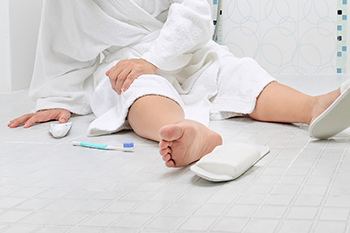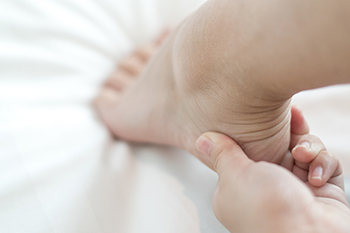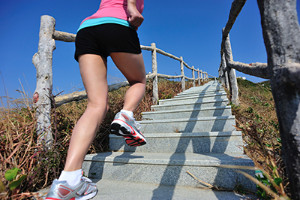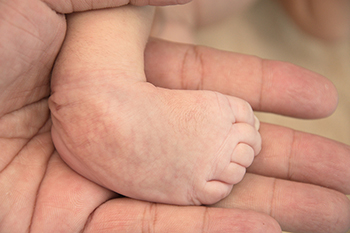Connect With Us
Blog
Items filtered by date: March 2022
Foot Problems and Falling as We Age
 Foot problems can lead to pain, swelling, numbness and tingling of feet. These symptoms can come from blisters, bunions, heel spurs, diabetes complications, hammertoes, and the like. Regardless of the cause, foot problems can impact balance and gait and contribute to falls. The elderly population is more vulnerable when it comes to foot problems and resultant falls. Simple walking impacts bones, joints, muscles, ligaments, and tendons and the longer we live, the more wear and tear on feet. As we age, padding on the bottom of the feet wears off, arches become flatter and less flexible, and ankles and joints become stiff. Feet even become wider and longer as we age. Pre-existing physical conditions impacting feet and ankles, like heart and vascular disease and kidney disease, puts one at greater risk for foot problems as well. All these natural changes can lead to foot pain and problems, such as arthritis and gout and increase the propensity for falling. Proper care of feet and regular exercise, with a focus on lower body strengthening, are important as we grow older. Regular consultation with a podiatrist can help one maintain foot health and prevent complications leading to falls as we age.
Foot problems can lead to pain, swelling, numbness and tingling of feet. These symptoms can come from blisters, bunions, heel spurs, diabetes complications, hammertoes, and the like. Regardless of the cause, foot problems can impact balance and gait and contribute to falls. The elderly population is more vulnerable when it comes to foot problems and resultant falls. Simple walking impacts bones, joints, muscles, ligaments, and tendons and the longer we live, the more wear and tear on feet. As we age, padding on the bottom of the feet wears off, arches become flatter and less flexible, and ankles and joints become stiff. Feet even become wider and longer as we age. Pre-existing physical conditions impacting feet and ankles, like heart and vascular disease and kidney disease, puts one at greater risk for foot problems as well. All these natural changes can lead to foot pain and problems, such as arthritis and gout and increase the propensity for falling. Proper care of feet and regular exercise, with a focus on lower body strengthening, are important as we grow older. Regular consultation with a podiatrist can help one maintain foot health and prevent complications leading to falls as we age.
Preventing falls among the elderly is very important. If you are older and have fallen or fear that you are prone to falling, consult with one of our podiatrists from Grobowski Foot & Ankle. our doctors will assess your condition and provide you with quality advice and care.
Every 11 seconds, an elderly American is being treated in an emergency room for a fall related injury. Falls are the leading cause of head and hip injuries for those 65 and older. Due to decreases in strength, balance, senses, and lack of awareness, elderly persons are very susceptible to falling. Thankfully, there are a number of things older persons can do to prevent falls.
How to Prevent Falls
Some effective methods that older persons can do to prevent falls include:
- Enrolling in strength and balance exercise program to increase balance and strength
- Periodically having your sight and hearing checked
- Discuss any medications you have with a doctor to see if it increases the risk of falling
- Clearing the house of falling hazards and installing devices like grab bars and railings
- Utilizing a walker or cane
- Wearing shoes that provide good support and cushioning
- Talking to family members about falling and increasing awareness
Falling can be a traumatic and embarrassing experience for elderly persons; this can make them less willing to leave the house, and less willing to talk to someone about their fears of falling. Doing such things, however, will increase the likelihood of tripping or losing one’s balance. Knowing the causes of falling and how to prevent them is the best way to mitigate the risk of serious injury.
If you have any questions, please feel free to contact one of our offices located in Bellevue, Seattle, and Issaquah, WA, . We offer the newest diagnostic and treatment technologies for all your foot care needs.
Why Your Heel May Be In Pain
Your feet take a pounding every day, and thankfully, the strong band of connective tissue on the sole of the feet (plantar fascia) is there to absorb a lot of this stress. However, the plantar fascia can eventually become overly stressed or damaged, and even suffer micro-tears where it attaches to the heel. This condition, known as plantar fasciitis, causes inflammation in the tissue and a great deal of heel pain. This pain may come on gradually and is usually at its worst first thing in the morning or after periods of rest. Once you start moving around the pain typically subsides, but eventually returns as the day progresses. What causes the plantar fascia to become damaged? There are many possible factors that can lead to plantar fasciitis such as: obesity, age, ill-fitting or non-supportive footwear, standing for long periods of time, excessive strain during exercise, tight Achilles’ tendons or calf muscles, running on hard surfaces, and certain foot disorders like flat feet or high arches. There are a variety of treatments that a podiatrist can administer to relieve the pain and reduced mobility associated with plantar fasciitis. If you have heel pain, it is suggested that you make an appointment with a podiatrist.
Plantar fasciitis can be very painful and inconvenient. If you are experiencing heel pain or symptoms of plantar fasciitis, contact one of our podiatrists from Grobowski Foot & Ankle. our doctors can provide the care you need to keep you pain-free and on your feet.
What Is Plantar Fasciitis?
Plantar fasciitis is the inflammation of the thick band of tissue that runs along the bottom of your foot, known as the plantar fascia, and causes mild to severe heel pain.
What Causes Plantar Fasciitis?
- Excessive running
- Non-supportive shoes
- Overpronation
- Repeated stretching and tearing of the plantar fascia
How Can It Be Treated?
- Conservative measures – anti-inflammatories, ice packs, stretching exercises, physical therapy, orthotic devices
- Shockwave therapy – sound waves are sent to the affected area to facilitate healing and are usually used for chronic cases of plantar fasciitis
- Surgery – usually only used as a last resort when all else fails. The plantar fascia can be surgically detached from the heel
While very treatable, plantar fasciitis is definitely not something that should be ignored. Especially in severe cases, speaking to your doctor right away is highly recommended to avoid complications and severe heel pain. Your podiatrist can work with you to provide the appropriate treatment options tailored to your condition.
If you have any questions please feel free to contact one of our offices located in Bellevue, Seattle, and Issaquah, WA, . We offer the newest diagnostic and treatment technologies for all your foot and ankle needs.
Can I Run After Foot or Ankle Surgery?
Runners, especially those who run long distances regularly, often get injured. Serious injuries can lead to surgery, either on the foot or the ankle. The question of when you can safely resume running depends on the type of injury and the site of the surgery. For anyone who has had a total ankle joint replacement, for instance, running will most likely be prohibited. As for other injuries, you may not be able to reach the previous levels or length or frequency of running you once enjoyed. As a rule, it takes about one year to fully recover from major foot surgery, because of swelling, gait asymmetry, and reduced muscle strength. Eventually, you may be able to ease back into activity, if you run only on soft surfaces and wear shoes that adequately cushion your feet. To be on the safe side, it is a good idea to check in frequently with a podiatrist who can evaluate your healing progress and guide you on how far and how often you can safely run again.
Exercising your feet regularly with the proper foot wear is a great way to prevent injuries. If you have any concerns about your feet, contact one of our podiatrists of Grobowski Foot & Ankle. our doctors will treat your foot and ankle needs.
How to Prevent Running Injuries
Many common running injuries are caused by overuse and overtraining. When the back of the kneecap starts wearing out and starts causing pain in your knee, this is commonly referred to as runner’s knee. Runner’s knee is a decrease in strength in your quadriceps and can occur if you’re not wearing properly fitted or supporting shoes. To prevent runner’s knee, focusing on hip strengthening is a good idea, as well as strengthening your quads to keep the kneecaps aligned.
What Are Some Causes of Running Injuries?
- One cause of a common running injury is called iliotibial band syndrome.
- Plantar fasciitis is also another common injury.
- Stress fractures can occur from overtraining, lack of calcium, or even your running style.
Best Ways to Prevent Running Injuries
- Wear footwear that fits properly and suits your running needs.
- Running shoes are the only protective gear that runners have to safeguard them from injury.
- Make a training schedule. Adding strengthening exercises as well as regular stretching can help keep you strong and limber and can lessen the possibility of injuries.
- Stretching keeps muscles limber; this will help you gain better flexibility.
If you have any questions please feel free to contact one of our offices located in Bellevue, Seattle, and Issaquah, WA, . We offer the newest diagnostic and treatment technologies for all your foot and ankle needs.
Wounds That Don't Heal Need to Be Checked
What Can Be Done if My Baby Has Clubfoot?
Some babies are born with a foot deformity called congenital talipes equinovarus, better known as clubfoot. Instead of the foot being straight, it twists inward because the tissues that connect the foot to the leg are shortened. Generally, the heel points downward and the toes point inward; the affected leg is shorter; the Achilles tendon is tight; and the affected foot is shorter and wider than the other foot. This condition is not usually painful, but it can result in other problems as your baby grows older and begins to walk. Causes of clubfoot can include family history, use of tobacco and/or alcohol during pregnancy, and congenital conditions related to spinal cord development. The most common way to treat clubfoot in babies is to stretch the foot and place it in a cast over a period of months. However, in more severe cases, various surgeries may be required. If your baby is born with clubfoot, it is a good idea to seek the advice of a podiatrist who can help to develop a regular treatment program as soon as possible.
Making sure that your children maintain good foot health is very important as they grow. If you have any questions, contact one of our podiatrists of Grobowski Foot & Ankle. our doctors can provide the care you need to keep you pain-free and on your feet.
Keeping Children's Feet Healthy
Having healthy feet during childhood can help prevent medical problems later in life, namely in the back and legs. As children grow, their feet require different types of care. Here are some things to consider...
Although babies do not walk yet, it is still very important to take care of their feet.
Avoid putting tight shoes or socks on his or her feet.
Allow the baby to stretch and kick his or her feet to feel comfortable.
As a toddler, kids are now on the move and begin to develop differently. At this age, toddlers are getting a feel for walking, so don’t be alarmed if your toddler is unsteady or ‘walks funny’.
As your child gets older, it is important to teach them how to take care of their feet.
Show them proper hygiene to prevent infections such as fungus.
Be watchful for any pain or injury.
Have all injuries checked by a doctor as soon as possible.
Comfortable, protective shoes should always be worn, especially at play.
If you have any questions please feel free to contact one of our offices located in Bellevue, Seattle, and Issaquah, WA, . We offer the newest diagnostic and treatment technologies for all your foot and ankle needs.
Causes of Overpronation
 Overpronation refers to the feet rolling excessively inward during walking or running. This results in more weight being placed on the inner side of the foot, which can eventually cause foot pain, plantar fasciitis, ankle injuries, shin splints, stress fractures, and more. Overpronation itself usually has a gradual onset and can be caused by a variety of biomechanical distortions in the foot and ankle. These include having flat feet, knock knees, excess weight, or weakness in the tibialis posterior muscle or the ligaments that support the feet. If you are suffering from foot pain, please seek the care of a podiatrist.
Overpronation refers to the feet rolling excessively inward during walking or running. This results in more weight being placed on the inner side of the foot, which can eventually cause foot pain, plantar fasciitis, ankle injuries, shin splints, stress fractures, and more. Overpronation itself usually has a gradual onset and can be caused by a variety of biomechanical distortions in the foot and ankle. These include having flat feet, knock knees, excess weight, or weakness in the tibialis posterior muscle or the ligaments that support the feet. If you are suffering from foot pain, please seek the care of a podiatrist.
If you have any concerns about your feet, contact one of our podiatrists from Grobowski Foot & Ankle. our doctors can provide the care you need to keep you pain-free and on your feet.
Biomechanics in Podiatry
Podiatric biomechanics is a particular sector of specialty podiatry with licensed practitioners who are trained to diagnose and treat conditions affecting the foot, ankle and lower leg. Biomechanics deals with the forces that act against the body, causing an interference with the biological structures. It focuses on the movement of the ankle, the foot and the forces that interact with them.
A History of Biomechanics
- Biomechanics dates back to the BC era in Egypt where evidence of professional foot care has been recorded.
- In 1974, biomechanics gained a higher profile from the studies of Merton Root, who claimed that by changing or controlling the forces between the ankle and the foot, corrections or conditions could be implemented to gain strength and coordination in the area.
Modern technological improvements are based on past theories and therapeutic processes that provide a better understanding of podiatric concepts for biomechanics. Computers can provide accurate information about the forces and patterns of the feet and lower legs.
Understanding biomechanics of the feet can help improve and eliminate pain, stopping further stress to the foot.
If you have any questions please feel free to contact one of our offices located in Bellevue, Seattle, and Issaquah, WA, . We offer the newest diagnostic and treatment technologies for all your foot and ankle needs.
Featured Articles
- May 2025
- April 2025
- March 2025
- February 2025
- January 2025
- December 2024
- November 2024
- October 2024
- September 2024
- August 2024
- July 2024
- June 2024
- May 2024
- April 2024
- March 2024
- February 2024
- January 2024
- December 2023
- November 2023
- October 2023
- September 2023
- August 2023
- July 2023
- June 2023
- May 2023
- April 2023
- March 2023
- February 2023
- January 2023
- December 2022
- November 2022
- October 2022
- September 2022
- August 2022
- July 2022
- June 2022
- May 2022
- April 2022
- March 2022
- February 2022
- January 2022
- December 2021
- November 2021
- October 2021
- September 2021
- August 2021
- July 2021
- June 2021
- May 2021
- April 2021
- March 2021
- February 2021
- January 2021
- December 2020
- November 2020
- October 2020
- September 2020
- August 2020
- July 2020
- June 2020
- May 2020
- April 2020
- March 2020
- February 2020
- January 2020
- December 2019
- November 2019
- October 2019
- September 2019
- August 2019
- July 2019
- June 2019
- May 2019
- April 2019
- March 2019
- February 2019
- January 2019
- December 2018
- November 2018
- October 2018
- September 2018
- August 2018




